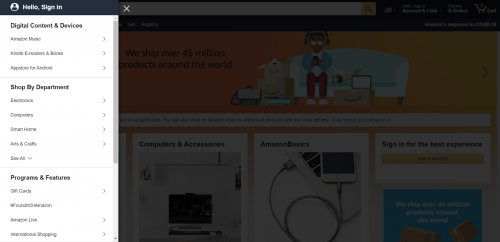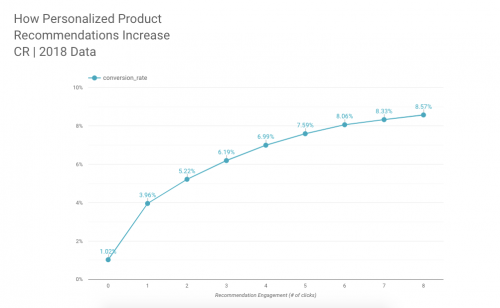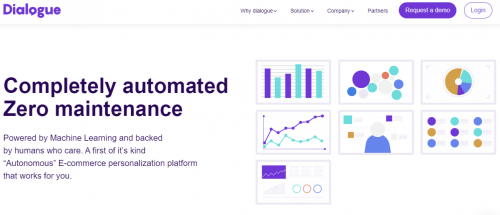
A good customer experience starts with having the right tools – Interview with Liat Bycel of Airtable
July 16, 2021
We are all only one moment away from creating a hyper fan – Interview with James Dodkins of Pega
July 27, 2021This is a guest post by Lucy Manole, a creative content writer and strategist at Marketing Digest.
Having a beautiful eCommerce website packed with stunning visuals surely helps in engaging your audience, but when it comes to driving and converting more visitors into customers, usability is the name of the game.
Website usability is all about building a storefront that’s intuitive and functional. And long story short, a more usable website helps your business rank higher on search engines, makes it easy for visitors to purchase, and ultimately keeps customers coming back for more.
While there’s a lot of complex stuff you can do to enhance the usability of your online store — such as incorporating an advanced AI-powered semantic search engine — here are four relatively quick and effective steps you can take to improve your website’s usability right away.
Keep the Navigation Simple
It may sound obvious, but your store’s navigation must be as straightforward as possible. Any sort of complexity hurts the user experience and thus, conversions.
Amazon is indeed the perfect example of smooth and easy eCommerce navigation, facilitating purchases.

The products are categorized well, the menu is uncluttered and easy to navigate, and there’s a search bar at the top that works well. Filtering products based on price, color, size, etc. is easy.
In essence, functional navigation evokes a sense of familiarity and makes your website more usable.
In the case of an eCommerce website, this also includes the checkout process. An elaborate or lengthy checkout process hurts usability and conversions. In fact, 18% of US adults have abandoned an order due to a “too long/complicated checkout process.”
During checkout, only ask for the details that are necessary to fulfill the order. Plus, the same research suggests that 24% of shoppers ditch their cart due to the reason “the site wanted me to create an account.”
So, don’t enforce account creation. Allow visitors to purchase seamlessly without signing up. If they are happy with the shopping experience, they are very likely to stick to your brand and create an account later.
Ensure Your Online Store is Optimized for Mobile
Over half of all internet traffic shopping now comes from a mobile device. In fact, 53.9% of all retail eCommerce is expected to be generated via mobile eCommerce in 2021.
And yet, 84% have experienced difficulty in finishing mobile transactions. This means ensuring the best possible mobile user experience will not only land you more sales but also help you stand out from your competition.
Not to mention Google’s mobile-first indexing means the mobile version of your store is how Google indexes your site and determines your rankings. So better mobile usability translates to better rankings.
Here are a few ways to ensure your eCommerce website’s usability is optimized for mobile:
- Use a responsive theme — so all the content, HTML, and URLs remain the same irrespective of the user’s device and screen size.
- Allow autofill for contact forms, make touch elements large enough with sufficient space to separate them, and go for bigger font size.
- Maximize site speed by enabling compression, avoiding redirects, improving server response times, minifying CSS and JS, leveraging browser caching, and optimizing images. Evaluate your site using Google’s PageSpeed Insights to find out how your site performs currently. Use the list of recommendations it provides to optimize your store’s speed on all devices.
In general, optimizing a visual-heavy eCommerce website with hundreds or even thousands of product pages for speed and SEO is a tall order, but using an eCommerce platform like Shopify or BigCommerce can dramatically ease things for you.

Source: Think with Google
Incorporate Live Chat and Chatbots
As you likely know, consumers today lack the patience (wears out at just 10 minutes) to wait for getting answers to their queries — 90% of consumers rate immediate response from businesses as “important” or “very important” when it comes to customer service.
This means the need for speed goes beyond your website’s loading speed — your business must be there for your customers when they need it.
Live chat enables your visitors and customers to have swift interactions with you. And as such, 41% of consumers prefer live chat as a way to reach out to support.
Live chat boosts your store’s credibility and makes customers feel someone is always available on your end.
Needless to say, however, it’s not feasible to have a 24/7 customer service team online.

Source: Pixabay
Enter chatbots — typically powered by basic AI tech, a chatbot is a nifty customer service tool that can provide on-the-spot answers to all your customers’ common concerns, so they don’t have to wait for a reply over email, call your business, fill out a form, or create helpdesk tickets.
And people like chatbots, with 35% of consumers wanting to see more businesses incorporating chatbots on their websites.
A chatbot is available 24/7, provides quick and accurate responses and is immune to frustration that can be caused by unruly customers. It helps automate tedious aspects of customer service so your support team can focus on fixing tricky customer issues and ensuring customer satisfaction.
A chatbot can also guide visitors to the different pages of your store based on what they’re looking for, enhancing the on-site experience. So while AI-based chatbots can’t replace human customer service, their benefits in improving website usability are undeniable.
Personalize the User Experience on Your Store
Barilliance conducted a study across 300 randomly selected customers and found that product recommendations account for up to 31% of eCommerce site revenues.

Clearly, the ability to serve personalized product and content recommendations goes a long way in improving your store’s user experience and thus, sales.
In fact, Amazon — highlighted earlier for its exemplar usability in terms of site navigation — attributes 35% of its revenue to personalized product recommendations, which are continually optimized to engage each individual user.
By using data from past purchases and items that are related and frequently bought together, along with analysis of shoppers’ patterns and specific preferences, an AI-powered tool like Dialogue AI can help you personalize your eCommerce experience, translating to superior usability, more sales, and higher customer retention rates.

Such a tool can display the most relevant product to every visitor that lands on the eCommerce store in real-time, and match the right messaging to them based on their customer journey.
Over to You
Usability is a crucial aspect of any website. And for eCommerce, where your business’s success relies entirely on your website’s quality — usability is even more important.
So be sure to work on the four tips outlined above, and you’ll drastically improve your online store’s usability without investing huge time and money.
This is a guest post by Lucy Manole, a creative content writer and strategist at Marketing Digest.
Author Bio
 Lucy Manole is a creative content writer and strategist at Marketing Digest. She specializes in writing about digital marketing, technology, entrepreneurship, and education. When she is not writing or editing, she spends time reading books, cooking and traveling.
Lucy Manole is a creative content writer and strategist at Marketing Digest. She specializes in writing about digital marketing, technology, entrepreneurship, and education. When she is not writing or editing, she spends time reading books, cooking and traveling.
Image by Megan Rexazin from Pixabay




